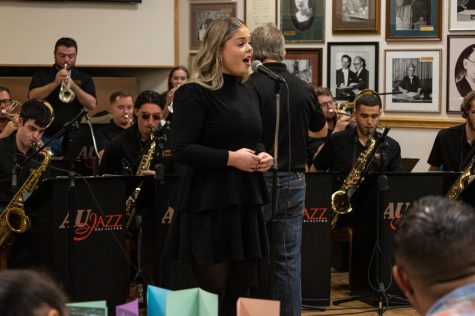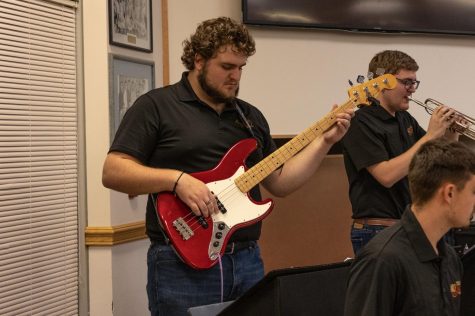How does the university use our money?
March 2, 2017
The average, full-time, on-campus freshman at Ashland University pays tuition, room and board (based on the regular double/triple room and the unlimited meal plan), an activity fee, health fee, technology fee, and a recreation fee. These costs amount to $29,994 per year to attend Ashland University.
Cost is one of the biggest influences on a young adult’s decision to continue their education past high school. Ashland University is a private university, meaning it does not receive funds from state legislatures like public colleges do. Private universities rely heavily on tuition and private contributions, and that money is carefully budgeted.
Business Office: Tuition
Stephen Storck, vice president and chief financial officer, said that the total operating budget for the university is about $95 million. This comes from annual audited financial statements from the university’s fiscal year of June 1, 2015 – May 31, 2016.
“Our tuition that we charge is almost $79 million in total revenue,” he said. That $79 million includes institutionally funded financial aid of $19 million, which essentially means that students are paying into their own (and others’) financial aid. Tuition and the financial aid make up 63 percent of the budget.
The other big item for the university is the money students pay for their room, board (meal plan), and bookstore, making up 21 percent of the budget. The university also receives gifts from alumni, foundations, and people that want to support it, contributing 10 percent of the budget.
Another one percent of the budget comes from endowment income. An endowment is money from a donor that cannot be spent, but is instead invested on things like stocks and bonds. The earnings on the investments are what can be spent.
“We have a spending policy that says we can spend no more than five percent of the value of that endowment, which makes up another portion of our budget, usually one percent,” Storck said.
“Think of it as a large pot of money,” Storck said. “All the money goes in the pot. We know what our revenue is, and we have budgets for all of our expenses: that pot of money is what funds the budget. When a student pays x amount of tuition, we don’t set aside or pigeonhole it to say, ‘this pays for this, this pays for this…’ The only time we do that is if a donor gives us restrictive money that can only be used for certain purposes.”
The largest portion of the budget goes towards the salaries and wages of both the professors and of course staff on campus who work to prepare the meals, clean and maintain the grounds and buildings, and people like Storck to provide office support, because even though Ashland University is non-profit, “we are not for loss, and we have to operate with good business practices.”
Not every student at Ashland University is the average, full-time, on-campus and unlimited meal plan student, but that money goes into the budget as well. The part-time tuition rate is $866 per credit hour, plus an additional eight dollars per credit hour activity fee and $15 per credit hour technology fee, and every student who takes more than 19 credit hours is charged the same $866 amount per extra credit hour.
Some students even pay more than the $154 health fee because they do not have insurance, through their parents or otherwise, which is $1,400. Storck said approximately 350 students purchase health insurance from the university every year.
Residence Life: Fines
Besides the money students pay for the allotted tuition amount, many students pay fines after being written up on campus for a parking ticket, misconduct, or some other factor. Those fines are not accounted for in the budget, so some departments keep those monies and use them in their department.
Kim Lammers, Director of Residence Life, said that the Res Life department gets money from a number of different things, one being the lock-outs, which are five dollars per incident.
“The reasoning behind a lock-out charge is that a locksmith will charge upwards of $35 if you lock yourself out of your house or apartment, so we are trying to teach responsibility to students,” Lammers said.
Res Life also collects money from break housing and early arrivals. Students have to fill out the proper forms before the submission deadline, and if they don’t, it costs them $50, on top the five dollars a day break rate and early arrival’s $25 a day rate.
Anything found in residence halls prohibited by the student handbook is removed and documented by the RA’s and goes through conduct process, and fines range depending on what the removed item is. Students can get those materials back from their RA’s when they go back home.
Ashland University is a dry campus. According to Lammers, the department is not responsible for returning alcohol paraphernalia but sometimes does because of important emotional value: however, say goodbye to that bottle of Jack because alcohol will not be returned.
Storck said since Student Affairs collects those fines, they use that money as they see fit.
“We put it towards education and training for our RA’s and office supplies; any money we have leftover we use for purchasing mattresses, or other furniture requested by residence councils,” Lammers said.
At the end of the year RA’s check students’ rooms. Any kind of damage to the room (walls, flooring, lights desks, or others), improper checkouts, excessively uncleanliness or trash is assessed and by Res Life and are sent to Facilities.
Facilities and Safety Services: Fines
Patrick Ewing, Vice President of Operations and Planning at Facilities Management, said that the charges are sent to them because the staff are the ones who clean and fix it, but those are not the only monies that fall under Ewing’s jurisdiction.
“Operations and Planning includes all maintenance, grounds, building services, mechanic services, locksmithing, student dining, bookstore, catering and conference, project planning and construction, the Columbus Center operations, and Strategic Planning,” he said.
Facilities does not directly collect money from students. Fees are usually assessed through student affairs and then the business office, and then funds are transferred to the appropriate repair lines as necessary, which is how most fine money at this university moves.
“We do not track collected fines,” he said. “However, we do spend an average of around $15,000 annually on vandalism related repairs and replacements. Some of this is from identified charges and fines, but most of it is not.”
Safety Services operates in a similar way to Facilities and the other departments at Ashland University.
Safety services helps students get back into their rooms for a five dollars fine like Res Life does. As for parking tickets, it is dependent upon factors like where the vehicle was, if it was during an event, how long it has been there, if the vehicle has a parking permit sticker visible, and more.
David McLaughlin, director of safety services, said those fines are used to cover departmental line items that are over budget.
“For the current fiscal year it will be used to help fund line items like printing expenses, equipment repair, postage and vehicle fuel,” McLaughlin said. “The amount received from lockouts though will not cover all the overages, but it does help.”
Sometimes unexpected events happen as well. The waterline that runs under the quad was leaking and had to be replaced, a large pine tree fell on the Chapel, and all of the ash trees had to be cut down because of the ash borers. Unexpected events can cause financial concerns. Storck said the university has a budget of over a million dollars to maintain the buildings and the grounds.
The university also has to account for inflation and rising costs of food, technology, gas, heating and air conditioning, and electric: which is why tuition is going to increase by 1.5 percent next year (a little under $500).
Even with paying approximately $30,000 for a full year, plus other potential fines, nobody is paying fully what it costs to educate them.
“In the fall of ‘14, the tuition price reset went into effect,” Storck said. “We lowered the cost of tuition by over $10,000, but we also lowered the amount of financial aid we provided. We’ve really been working hard to keep the amount of tuition, so over time we have decreased the number of employees at the university and we have really been watching what we spend, but next year tuition is going up by 1.5%. We are a business and we have to be business-like. It’s unfortunate, but that is the reality.”









